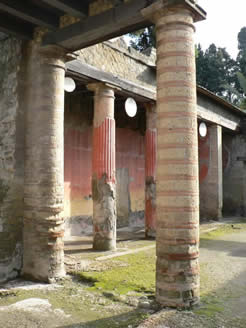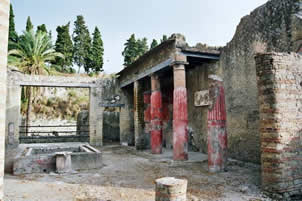 HERCULANEUM
HERCULANEUM


A History of Herculaneum:
Just a stone’s throw from Naples, on the edge of the town of Resina, overlooking the Gulf of Naples, we find the remains of ancient Herculaneum, one of the most important and significant archaelogical sites in Italy.
Mythological tradition suggests the town was founded by none other than Hercules, upon his return from Iberia where he performed the tenth of his twelve terrible labours by capturing the flocks of the monster Geryon. Thus we have a town called Herculaneum by the Romans and Herakleion by the Greeks.
Historically, Herculaneum actually did have Greek origins, little trace remains apart from a few metres of the ancient walls and the layout of the town; the cardines and decumani (i.e. the main rods running in a north-south pattern, here parallel to the coastline, and the secondary ones running in a east-west pattern, where they are perpendicular to the coast and very steep) built at right angles in a strict regular pattern, reminding us of the ancient Greek town of Neapolis.
The Greeks of Neapolis and the other major Greek colony of the area, Cumae (who already controlled much of the Campanian coast, from Cumae to the Sorrento peninsula)
Ruled Herculaneum from the 6th century B.C. Nearly a century later the Samnites gained control, and remained in power for centuries. We can see some very interesting inscriptions in the Osco-Samnite language that have survived this period.
Between the 2nd and 1st centuries B.C. Herculaneum was one of the Campanian towns which fought against Roman domination in the “Allies’ War”. In 89 B.C. Herculaneum was conquered by one of Sulla’s legates, forced to yield to Rome and subsequently became a Roman muncipium.
After this time Herculaneum must have undergone a degree of demographic, political and urban development. Very popular with Roman patricians, mainly because of its very mild climate and its enviable geographical position. The town of Hercules was small in size, about a third of the size of Pompeii, situated on the furthest slopes of Vesuvius on a promontory between two rivers, overlooking the sea to the south. As a result of two events, the eruption of Vesuvius in 79A.D. and a second eruption in 1631, the lie of the land was radically altered, raising it over 20 metres above its ancient level.
Herculaneum , the Resort of the Romans:
Unlike nearby Pompeii, a primarily mercantile town, Herculaneum’s economy was not based on commerce and crafts, although they flourished, as exhibited by the many household articles found. The town was actually a well-known high-class resort which contained many elegant, elaborate patrician residences, “custom homes” having a wealth of luxurious decorations, often situated in panoramic positions on the slopes of the vineyard covered hills. This is strong contrast to the humbler urban dwellings of the plebeians of Pompeii.
Pedestrians walked quietly along the town’s roads, which were not crowded with vehicular traffic used for trade as in Pompeii. Life in Herculaneum moved at a fairly gentle pace, relaxation was an important part of the Roman patricians’ leisure time. Without the industrial and commercial activities or the animations of the socio-political turmoil suggested by the numerous wall inscriptions of Pompeii, Herculaneum was the perfect choice.
The Buildings of Herculaneum:
House of Stags: Probably built between 41 and 68 A.D. this is one of the most elegant homes found in Herculaneum. This ever expanding building consists of a large rectangle, the longer side of which measures 43 metres, divided into two areas, a north area comprising of terraces overlooking the sea and connected by a four-sided windowed portico. The roofed atrium, whose walls are decorated by architectural elements against a black background to halfway up and a white background on the other half, leads to the triclinium, outstanding for the elegant marble decoration covering the floor. The sculptured group of “Deer attacked by Dogs” after which the house is named was found in this room. We continue on to the cubiculum, with its red-painted walls and amrble floor, followed by a room with vaulted ceiling decorated in the same way, in which a small statue of a “Satyr with Wineskin” was found. After going through the inner garden, around which runs a four-sided windowed portico with mosaic floor and walls decorated with elegant frescoes depicting “Cherubs’ Games”, we enter into the large summer triclinium to the south, at the sides of which there are two small rooms decorated with precious marbles, followed by a loggia with four pillars, also flanked by two rooms, in one of which the statuette of “Hercdules inebriated” was found.
House of the Neptune and Amphitrite Mosaic: An elegant two story house outstanding for the loveley summer triclinium with a nymphaeum decorated with colored mosaics portraying among other things, “Neptune and Amphitrite” and “Hunting Scenes” The shop annexed to the house is very interesting, it is one of the best preserved from ancient times, and the wooden structures and many of the furnishings are in perfect condition. Specimens of the goods on sale can be seen on the counter.
The “Suburban” Baths: Probably the best preserved baths of antiquity (they date from the second half of the 1st century A.D. and are therefore later than the other Baths in Herculaneum. The baths are arranged in a square plan, with an elegant outer portal leading down into a vestibule. The vestibule, illuminated by a light shaft resting on four columns surmounted by twin arches, leads to the various rooms of the Baths, which have marble floors, seats, and decorations and in some cases, wooden doors and window frames in an excellent state of preservation. The frigidarium, containing the pool used for cold baths, is still well preserved like the fistula (water pipe) that supplied it, leads to a room decorated with stucco reliefs portraying warriors. Next, we arrive at the tepidarium equipped with a central tank filled with lukewarm water, the laconicum or sudatorium (used for steam baths) and finally the calidarium, with a hot water pool.

The City Baths: Built around 10 B.C. and redecorated during the mid 1st century A.D. this complex has four entrances: one on Cardo No. 3, which accesses the men’s section and three on Cardo No. 4. One can enter the gymnasium courtyard from No. 7, the ladies section from No. 8 and from No. 10 we enter the praefurnium, a room used to heat the water. The ladies section, which is the smallest and least decorated but has the best preserved structure, opens with a large quadrangular waiting room with a continuous bench running along its walls. This room leads us to the podyterium (changing room) which has a mosaic floor depicting Triton, dolphins and other sea creatures, a stucco decorated roof, and compartmental shelving where clothes were left. To the left of the changing room is the tepidarium, which also has a mosaic floor with geometrical patterns and cupboards for clothes. Continue on to the calidarium, mainly of interest here is the hanging or suspended floor with allowed warm air to circulate. The men’s section has the gymnasium area in the middle and a peristyle on three sides with a narrow corridor leading off it. The gymnasium leads directly to the large apodyterium, with stucco decorated barrel vaults and a black and white patterned floor and seats installed on three sides, shelves for leaving clothes on the two longer sides and a marble tank for abulations on the end wall in an apse. A passage on the left leads to the frigidarium, where the figures of fish decorating the vault of the dome must have been reflected in the water of the circular pool, with its blue painted walls, producing a very attractive effect. We now return to the changing room, which leads to the tepidarium. Again we have the hanging floor as in the ladies section and the furnishings are arranged in exactly the same manner. The mosaic floor portrays a “Galloping Triton”. The calidarium, whose vaulted ceiling was damaged, has a pool which would have been filled with hot water on one side and the dais of the labrum (tank for abulations) on the other side in an apse.